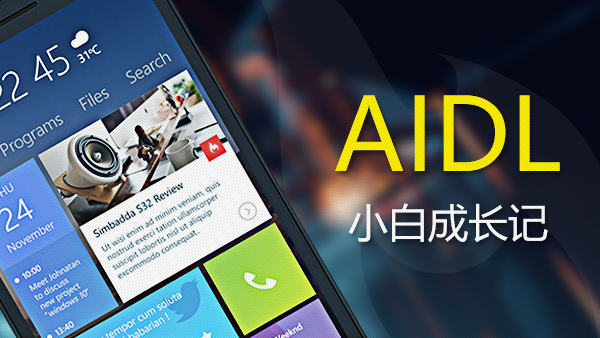什么是TabLayout

上图中,我们可以看到,该页面分成三个页签,每个页签对应不同的内容,如果让我们来实现布局的话,我们会很容易地想到布局为一个页签指示器+ViewPager,以前,相信各位大多使用的是GitHub上的开源框架PagerSlidingTabTrip来实现指示器的效果,而如今,Android中也有自带这种指示器的控件TabLayout,TabLayout存在于android design库中,它提供了一个水平的布局来展示Tabs。
一 如何使用TabLayout
1.要使用TabLayout,首先要添加 android support design包的依赖,在app模块的build.gradle中添加:
dependencies {
...
compile 'com.android.support:design:26.0.0-alpha1'
}2.在布局文件的xml中,使用TabLayout:
<?xml version="1.0" encoding="utf-8"?><LinearLayout xmlns:android="http://schemas.android.com/apk/res/android" android:layout_width="match_parent" android:layout_height="match_parent" android:orientation="vertical" > <android.support.design.widget.TabLayout android:id="@+id/tab" android:layout_width="match_parent" android:layout_height="wrap_content"> <android.support.design.widget.TabItem android:layout_width="wrap_content" android:layout_height="wrap_content" android:text="页签1" /> <android.support.design.widget.TabItem android:layout_width="wrap_content" android:layout_height="wrap_content" android:text="页签2" /> <android.support.design.widget.TabItem android:layout_width="wrap_content" android:layout_height="wrap_content" android:text="页签3" /> </android.support.design.widget.TabLayout></LinearLayout>
代码中我们可以看到,<TabLayout></TabLayout>之间包裹着TabItem,也就是每个页签的配置,我们这里只是简单地配置了文字,
3.如何设置页签的点击事件
在java文件中,我们根据id找到TabLayout,为其添加页签选中的监听,当选中标签的时候,弹出对应标签的文字:
TabLayout tabLayout = (TabLayout) findViewById(R.id.tab);
tabLayout.addOnTabSelectedListener(new TabLayout.OnTabSelectedListener() { @Override
public void onTabSelected(TabLayout.Tab tab) {
Toast.makeText(TabLayoutActivity.this, tab.getText(), Toast.LENGTH_SHORT).show();
} @Override
public void onTabUnselected(TabLayout.Tab tab) {
} @Override
public void onTabReselected(TabLayout.Tab tab) {
}
});效果如图:

动态创建Tab
上面我们简单演示了在布局文件中配置了TabLayout和对应的页签TabItem,接下来我们演示如何动态创建页签,修改布局文件:
<?xml version="1.0" encoding="utf-8"?><LinearLayout xmlns:android="http://schemas.android.com/apk/res/android" android:layout_width="match_parent" android:layout_height="match_parent" android:orientation="vertical" > <android.support.design.widget.TabLayout android:id="@+id/tab" android:layout_width="match_parent" android:layout_height="wrap_content"/></LinearLayout>
在Activity中找到TabLayout,并为其动态添加Tab:
public class TabLayoutActivity extends AppCompatActivity { private String[] titles = new String[]{ "体育", "社会", "新闻"
}; @Override
protected void onCreate(Bundle savedInstanceState) { super.onCreate(savedInstanceState);
setContentView(R.layout.activity_tab_layout);
TabLayout tabLayout = (TabLayout) findViewById(R.id.tab); for (int i = 0; i < titles.length; i++) {
TabLayout.Tab tab = tabLayout.newTab();//创建tab
tab.setText(titles[i]);//设置文字
tabLayout.addTab(tab);//添加到tabLayout中
}
tabLayout.addOnTabSelectedListener(new TabLayout.OnTabSelectedListener() { @Override
public void onTabSelected(TabLayout.Tab tab) {
Toast.makeText(TabLayoutActivity.this, tab.getText(), Toast.LENGTH_SHORT).show();
} @Override
public void onTabUnselected(TabLayout.Tab tab) {
} @Override
public void onTabReselected(TabLayout.Tab tab) {
}
});
}
}效果如图:

为Tab设置图标
Tab的创建是通过调用TabLayout的newTab()方法,创建出来的Tab对象即页签对象,除了setText()方法设置文字外,还可以设置对应的图标,通过调用setIcon()方法,就可以设置Tab的图标:
for (int i = 0; i < titles.length; i++) {
TabLayout.Tab tab = tabLayout.newTab();//创建tab
tab.setText(titles[i]);//设置文字
tab.setIcon(R.mipmap.ic_launcher);//设置图标
tabLayout.addTab(tab);//添加到tabLayout中
}效果如图:

设置更加美观的Tab
如果不喜欢图标在页签的上面,有别的需求,比如图标在页签的左边,那么这时,可以使用Tab的setCustomView(View view)方法,可以通过布局填充器将自己布局好的xml填充成View对象,然后设置进去,就可以实现更加美观的页签了,有兴趣的同学可以试试看。
修改TabLayout的样式
Tablayout支持定制化修改,提供了不少自定义属性供开发者进行设置。有以下属性支持修改:
tabBackground="" tablayout的背景颜色 tabIndicatorColor="" 指示器的颜色 tabIndicatorHeight="" 指示器的高度 tabGravity="" 指示器的位置 tabMode="" 显示模式 tabSelectedTextColor="" 选中时文字颜色 tabTextColor="" 未选中时文字颜色 tabTextAppearance="" 字体外观 tabMaxWidth="" tab最大宽度 tabMinWidth="" tab最小宽度 tabPadding="" tab内边距
自定义TabLayout:
下面我们简单修改下TabLayout提供修改的属性,看看修改后是怎样的效果,修改布局文件:
<android.support.design.widget.TabLayout android:id="@+id/tab" android:layout_width="match_parent" android:layout_height="wrap_content" app:tabBackground="@color/colorPrimary" app:tabIndicatorColor="@android:color/darker_gray" app:tabIndicatorHeight="5dp" app:tabSelectedTextColor="@android:color/holo_blue_light" app:tabTextColor="@android:color/white" app:tabTextAppearance="@style/TabTextStyle" />
这里我们为TabLayout设置了蓝色的背景色,设置了指示器的高度和颜色(灰色),设置了选中时文字的颜色为浅蓝色,未选中时为白色,还设置了字体的外观,字体的外观设置需要在style.xml中定义样式,如下:
<style name="TabTextStyle" parent="TextAppearance.Design.Tab"> <item name="android:textSize">16sp</item></style>
这里定义了字体的大小,样式中还可以设置字体其他外观,比如设置字体是否加粗等。
看一下自定义的TabLayout效果:

可以看到,效果和我们设置的一样。
Tab的位置和显示模式(tabGravity和tabMode)
1.tabGravity有两个值可选,分别是center(居中)和fill(填满),默认tabGravity="fill",填满,我们将它设置为center,看下效果:
<android.support.design.widget.TabLayout android:id="@+id/tab" android:layout_width="match_parent" android:layout_height="wrap_content" app:tabBackground="@color/colorPrimary" app:tabIndicatorColor="@android:color/darker_gray" app:tabIndicatorHeight="5dp" app:tabSelectedTextColor="@android:color/holo_blue_light" app:tabTextColor="@android:color/white" app:tabTextAppearance="@style/TabTextStyle" app:tabGravity="center" />

可以看到TabLayout的宽度没有填满,而且整个TabLayout居中显示。
2.当有很多个tab,多到屏幕放不下的时候,比如今日头条的TabLayout,我们需要将TabLayout的显示模式tabMode更改为scrollable,这样整个TabLayout就可以左右滑动,TabLayout默认tabMode为fixed(固定),我们将其修改为scrollable:
<android.support.design.widget.TabLayout android:id="@+id/tab" android:layout_width="match_parent" android:layout_height="wrap_content" app:tabBackground="@color/colorPrimary" app:tabIndicatorColor="@android:color/darker_gray" app:tabIndicatorHeight="5dp" app:tabSelectedTextColor="@android:color/holo_blue_light" app:tabTextColor="@android:color/white" app:tabTextAppearance="@style/TabTextStyle" app:tabGravity="center" app:tabMode="scrollable" />
添加多一些页签:
String[] channels = getResources().getStringArray(R.array.channel); for (int i = 0; i < channels.length; i++) {
TabLayout.Tab tab = tabLayout.newTab();//创建tab
tab.setText(channels[i]);//设置文字
tabLayout.addTab(tab);//添加到tabLayout中
}channel是一个定义在xml中的string-array:
<?xml version="1.0" encoding="utf-8"?><resources> <string-array name="channel"> <item>推荐</item> <item>视频</item> <item>热点</item> <item>社会</item> <item>娱乐</item> <item>科技</item> <item>汽车</item> <item>体育</item> <item>财经</item> <item>军事</item> <item>国际</item> <item>时尚</item> <item>游戏</item> <item>旅游</item> <item>历史</item> <item>探索</item> <item>美食</item> <item>育儿</item> <item>养生</item> <item>故事</item> <item>美文</item> </string-array></resources>
运行的效果如下:

可以看到TabLayout有许多Tab,且可以左右滑动。需要注意的是,当设置tabMode为scrollable时,此时设置tabGravity已经无效,无论设置为哪个值,它都是填满的效果。
TabLayout结合ViewPager
TabLayout + ViewPager 在开发中经常使用到,即上面显示页签,下面展示不同的fragment,就如今日头条,现在我们仿造今日头条的首页,演示下如果使用TabLayout + ViewPager。
首先,在布局文件中配置TabLayout和ViewPager:
<?xml version="1.0" encoding="utf-8"?><LinearLayout xmlns:android="http://schemas.android.com/apk/res/android" xmlns:app="http://schemas.android.com/apk/res-auto" android:layout_width="match_parent" android:layout_height="match_parent" android:orientation="vertical"> <android.support.design.widget.TabLayout android:id="@+id/tab" android:layout_width="match_parent" android:layout_height="wrap_content" app:tabBackground="@color/colorPrimary" app:tabIndicatorColor="@android:color/darker_gray" app:tabIndicatorHeight="5dp" app:tabSelectedTextColor="@android:color/holo_blue_light" app:tabTextColor="@android:color/white" app:tabTextAppearance="@style/TabTextStyle" app:tabGravity="center" app:tabMode="scrollable" /> <android.support.v4.view.ViewPager android:id="@+id/vp_content" android:layout_width="match_parent" android:layout_height="0dp" android:layout_weight="1" /></LinearLayout>
java文件中,设置TabLayout和ViewPager关联起来:
public class TabLayoutActivity extends AppCompatActivity { private TabLayout mTabLayout; private ViewPager mVpContent; private List<ContentFragment> mFragments = new ArrayList<>(); private String[] mTitles; @Override
protected void onCreate(Bundle savedInstanceState) { super.onCreate(savedInstanceState);
setContentView(R.layout.activity_tab_layout);
initView();
initData();
initListener();
} private void initView() {
mTabLayout = (TabLayout) findViewById(R.id.tab);
mVpContent = (ViewPager) findViewById(R.id.vp_content);
} private void initData() {
mTitles = getResources().getStringArray(R.array.channel); for (int i = 0; i < mTitles.length; i++) {
ContentFragment fragment = new ContentFragment();
Bundle bundle = new Bundle();
bundle.putString(ContentFragment.TEXT, mTitles[i]);
fragment.setArguments(bundle);
mFragments.add(fragment);//添加到fragment中
}
} private void initListener() {
TabAdapter tabAdapter = new TabAdapter(getSupportFragmentManager(), mFragments, mTitles);
mVpContent.setAdapter(tabAdapter);//为viewPager设置adapter
mTabLayout.setupWithViewPager(mVpContent);//将TabLayout和ViewPager关联
}
}运行的效果如下:

可以看到,TabLayout和ViewPager已经关联起来,当点击页签的时候,ViewPager会切换到对应的fragment,滑动ViewPager,对应页签也会跟着改变。
这里需要注意的是,实现ViewPager的adapter时,需要重写Adapter的getPageTitle()方法,返回对应页签的内容,这样TabLayout才会有对应的页签。
好了,到这里关于TabLayout的介绍就到此为止了,想看源码的话,可以点击以下链接:

 随时随地看视频
随时随地看视频




